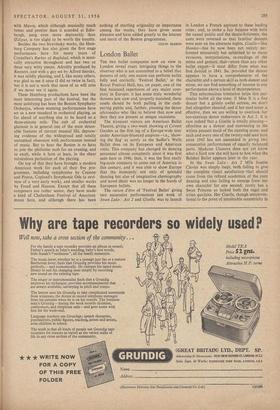London Ballet
THE two ballet companies now on view in London reveal many intriguing things to the observer who is not committed to a belief that dancers of only one nation can perform ballet fully and correctly. 'Festival Ballet,' at the Royal Festival Hall, has, on paper, one of the best balanced repertoires of any major com- pany in Europe; it has some truly wonderful dancers just now and, properly matched, these assets should be both pulling in the cash- paying public and, further, pleasing the dance aficionados who like to believe that now and then they are present at unique occasions.
The transient visitors are American Ballet Theatre, giving a two-week showing at Covent Garden as the first leg of a Europe-wide tour under American-financed auspices—i.e., 'show- ing the flag' as surely as the Sadler's Wells Ballet does on its European and American visits. This company has changed its dancing personnel almost completely since it was first seen here in 1946; then, it was the first really big-scale company to come out of America in this century, and it was able to show Europe that the monopoly not only of splendid dancing but also of imaginative choreography and novel decor was no longer in the hands of European ballets.
The raison d'être of 'Festival Ballet' giving two successive performances last week of Swan Lake : Act 2 and Giselle, was to launch in London a French aspirant to these leading roles: and, to strike a fair balance with both the casual public and the dance-followers, the casts were reversed so that familiar dancers were seen on the alternate nights. Giselle—like Hamlet—has by now been not merely per- formed excessively but subjected to so many revisions, interpolations, re-readings of the mime and gesture, that—more than any other ballet extant—it must differ from what was first danced in 1841. So, provided the dancer appears to have a comprehension of the character and a certain skill as both dancer and mime, we can find something of interest in any performance above a level of incompetence.
This subconscious toleration helps this par- ticular ballet all the time; if Miss X is a fine dancer but a grimly awful actress, we don't feel altogether cheated; and if her mad scene is effective, then we are willing to overlook her too-cautious dance endeavours in Act 2. It is rare indeed that a Giselle is totally pleasing— effortless as a dancer and convincing as the witless peasant maid of the opening scene; and each and every one of the twenty-odd seen here since 1945 has not succeeded in giving two consecutive performances of equally balanced parts. Madame Ulanova does not yet know what a hard row she will have to hoe when the Bolshoi Ballet appears later in the year.
In the Swan Lake : Act 2 Mlle Josette Clavier was simply inept, both failing to give the complete visual satisfaction 'that should come from the refined academics of the pure dancing and also failing to emerge from her own character for one second; rarely has a Swan Princess so lacked both the regal and avian qualities. Her Giselle, though unconven- tional to the point of intolerable eccentricity in some respects, was a whole piece; I found her wonderful and appalling at moments, in both aspects of the character. She has a hard, Latin look which turned her into a gipsy-likc per- sonality in her scene of madness, which she acted with a house-stilling intensity. In the- graveyard scene, where she appears as a wraith haunting her seducer, the (lancing was intelli- gently understood but not effortlessly projected ----and the illusion of total -case is essential if the silly story is to make any point.'
One must not probe into he reasons why Mlle Clavier was so presented, considering the weight of some of the ballerina talents in the company. Belinda Wright, partnered under- standably and carefully by Antqn Dolin, had made a splendid performance out of it—against her natural bent, one would have thought, for she is a brilliant classical executant—a dancer first and foremost, not a mime.
After these wonders the 'impact of the Americans was altogether quieter. The style of Les Sylphides (by now as much due for a long retirement from programmes as is Giselle) is unbelievably clean, delicate, inhuman—so much so that in place of the delight one should experience in its pristine lyricism, one could only winder at the marvellous discipline which braced the dancers against one of the keenest but coldest audiences they will ever have to face. It was all meticulous, calculated, with the formally exqursite patterns unfolding in an inevitable logic and power—but un- touched by any sort of human sensation. This may be the absolute value of American use of the classical balletic mode; they know exactly how to absorb its technical ferocities of physical movement and balance and controlled, alert stasis; but the temperament does not enable them to use this apparatus as a sort of transparent substance .through which the human creature boldly thrusts out.
Of purely American material, the folk- lorist narrative of Lizzie Borden (Fall River Legend)is too physically agonising to be made into good stage dancing. Agnes de Mille's choreographic method is a mingling of classicism (with large chunks of meaningful- ness laid on it) and the freer forms of American social dancing, and to this is added the Stanislavskian super-realism of Lizzie's acting—contorted face, clenching and grasping gestures, violent jerks and twists of the body. The balance is not struck and, instead of being moved, we are put off by the prolonged violences. The Town) is dead right: exuberant, boastful, oozing with the sophisticated charm of the Modern American Miss and her dog-faithful boy friends. These and other ballets were carried off by some stunning dancing from the top-liners, most notably Nora Kaye, Ruth Ann Koesun, John Kriza and Erik Bruun.
A. V. COTON



































 Previous page
Previous page